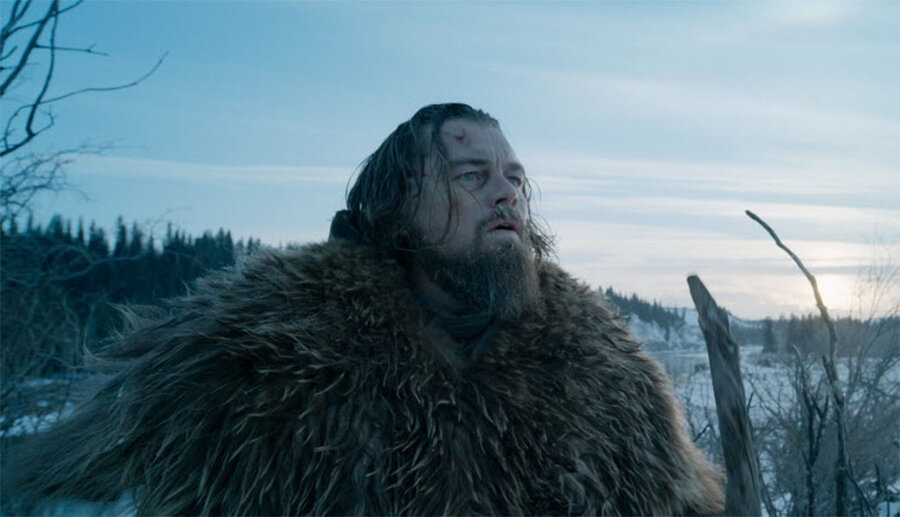'The Revenant' star Leonardo DiCaprio: 'It's a really primal story of man and the natural world'
Loading...
Alejandro G. Inarritu knew Leonardo DiCaprio would go to the ends of the earth to make the 19th century survival epic "The Revenant" exactly as the famously meticulous director wanted.
For Inarritu, DiCaprio was the best person to play Hugh Glass, a real-life fur trapper who survived a bear mauling and then went to find his mates who left him for dead in the unforgiving wilderness. Over the course of the nearly yearlong production, the Oscar-nominated actor and environmentalist proved his commitment over and over. He ate raw bison. He stripped naked in sub-zero temperatures. He even jumped into an icy river. But, early on, Inarritu had one very specific worry: Could DiCaprio grow a beard?
"You cannot shoot this film with a fake beard. It would look terrible," Inarritu said in a recent interview. "Not every man grows so much hair in his face. That was a bet."
Thankfully for the director, DiCaprio sprouted a gnarly, unruly beard that becomes a symbol of where exactly his character is on his journey and how deeply he's devolved. Makeup added dirt on a daily basis, and a combination of glycerin and grit gave his hair that unwashed, bloody look – the look of someone who'd survived a bear attack.
It's a minor thing, and perhaps the easiest test DiCaprio had to endure to make the sprawling epic, but it's one of those details that illustrate the overall production's commitment to authenticity.
"It's a really primal story of man and the natural world," said DiCaprio in a recent phone interview. "It's almost biblical."
In an era of computer-generated imagery and other post-production fixes, this was an unconventional shoot from the outset. Inarritu traveled with his crew to Calgary, Alberta and then to Argentina when the Canadian snow melted earlier than expected. As if shooting on location isn't hard enough, he and cinematographer Emmanuel "Chivo" Lubezki also opted to shoot only in natural light, giving the production a mere 90 minutes a day to achieve complex, highly-choreographed long takes. The duo had done this before in "Birdman," but never in the unpredictable wilderness.
But DiCaprio knew very well what he was signing up for.
"When you're out in the elements like this – and there are people who have much harder jobs than people making a movie – but you just appreciate the endurance of man and how we're able to adapt to circumstances," DiCaprio said. "You're signing on to find elements that will ultimately transform the narrative and find the poetry. ... It was all basically us really putting ourselves in this environment and seeing what happens."
Partly by nature of the story and partly for the sake of his character, DiCaprio largely isolated himself from the rest of the cast, including his friend Tom Hardy.
He studied the life of Hugh Glass and the lives of fur trappers at the time. He learned and practiced the choreography for the shots, too. But when it came time for the cameras to roll, everything became very animalistic – a largely silent performance rooted in instinct and reaction.
"For me, it was about really thinking these thoughts and really trying to feel this man's pain," DiCaprio said.
"Leo thinks like a filmmaker more than an actor," Inarritu said. "He understands the whole. He was able to be not only a machine doing exactly what we agreed in a natural way but at the same time be absolutely present to react to any improvisation. That's when I felt that this is one of the greatest actors."
Little remains of DiCaprio's full mountain man transformation externally. Production wrapped. He shed the beard. The bumps and bruises healed. But the grit of the shoot, the trials and tribulations, the tension of getting that perfect shot, it's all left on the screen – particularly in the bear attack.
"I think it will go down in history as one of the most voyeuristic action sequences ever created," DiCaprio said. "You feel the blood and the sweat. You almost smell the bear. It accomplishes what movies do at their best which is to really make you feel like the rest of the world has evaporated and you're singularly in that moment."
Inarritu wants to keep the specifics of how exactly he achieved such a harrowing sequence to himself. Revealing the process would destroy the magic of it all, he said.
"I wanted for people (to) feel the cold, smell the fear," he said. "It was difficult but that's what we were supposed to do. Nobody should care. Nobody should be bothered with having a good time or not. That's not the purpose of doing a film.
"Judging by the results, I would not change a bit."







